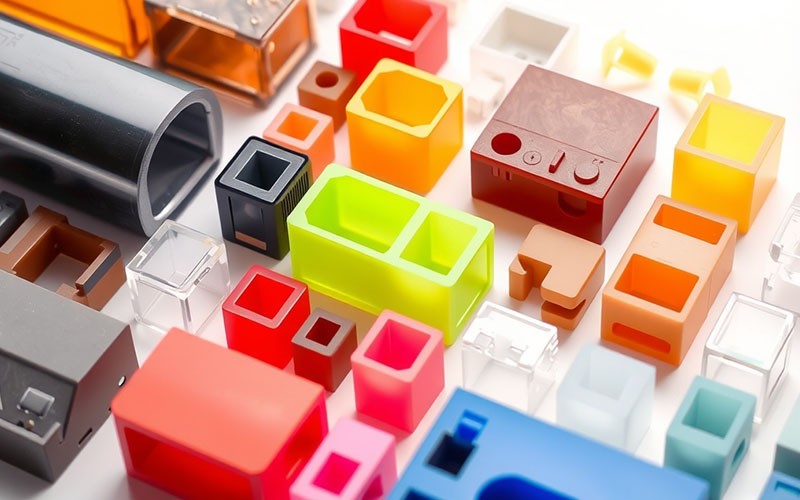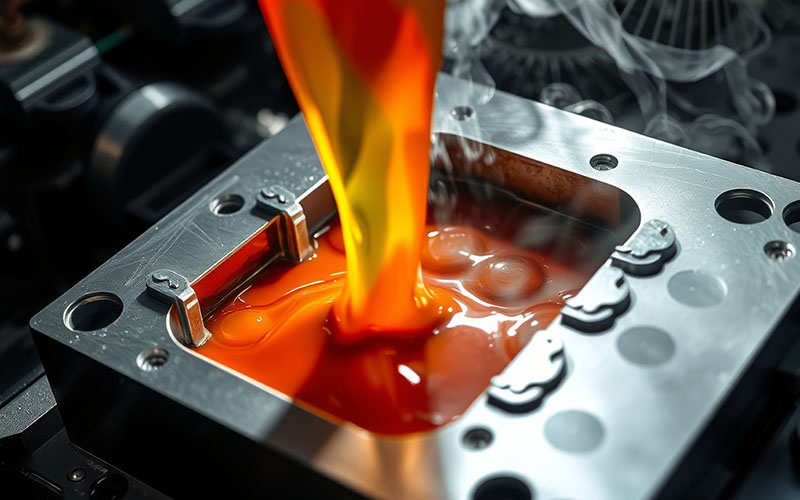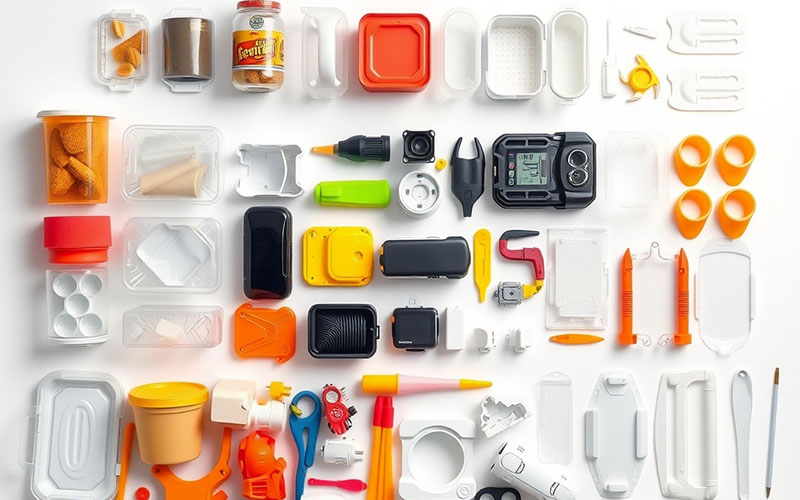Biarkan Istar membantu Anda memulai proyek Anda dengan pengalaman dan pengetahuan kami!
Unggah file desain dan persyaratan produksi Anda dan kami akan menghubungi Anda dalam waktu 30 menit!

Picking the right material is super important for a project’s success. It’s not just about picking any plastic. You need to know how different plastics act inside the mold and how they will work as a finished part. This article will show you the most common plastics used for injection molding. I’ll explain everything you need to know, from what different polymers are like to how to choose the best plastic for your plastic parts. If you are new to plastics or have lots of experience, this guide will help you make smart choices and stay away from expensive errors.
When we talk about plastics for injection molding, we are usually talking about a kind of plastic called a thermoplastic. Think about butter. You can melt it, let it cool down and get hard, and then melt it again. A thermoplastic polymer acts in a similar way. You can heat it up to a liquid, shoot it into a mold, let it cool to a solid part, and you could even grind that part up and use the plastic again. Being able to be melted and shaped again is what makes thermoplastics great for the injection molding process. It is a good way to make lots of plastic parts quickly.
The other big type of plastic is a thermoset. Unlike a thermoplastic, a thermoset changes chemically when it’s heated and shaped in a mold. Think of baking a cake. Once you bake the batter, you can’t change it back to a liquid. It is a one-time thing. For most of the injection molded products we see every day, from car parts to plastic toys, a thermoplastic is the material picked. Because it can be used in many ways and can be recycled, it is a top choice for lots of different injection molding jobs. Knowing this simple difference is the first step to picking the right material to use for your project’s mold.

Picking materials for your injection molded parts can seem like a lot. There are so many different kinds of plastic, each with its own special features. So, how do you choose? I always start by asking some questions about the finished part. What will this part be used for? Does it need to be strong? Flexible? Does it need to be clear? Will it be around chemicals or high heat? The answers to these questions will help you choose. You need to match the material’s abilities to the part’s needs.
For instance, if you’re making a part for the automotive industry, you might need a material that can handle high heat and is very strong. If you’re making medical devices, you’ll need a plastic that is safe for the human body and can be cleaned with heat. The main thing is to think about where the part will be and what kinds of stress it will have. Making a list of “must-have” features is a great way to start. This helps you narrow down all the material choices based on what is really important for your injection molded plastic part. Picking the right material for your project from the beginning saves time and money.
If you have ever looked at the bottom of a plastic container and seen the number “5” in the recycling symbol, you have seen polypropylene (PP). It’s one of the most used plastics in the world for a good reason. Polypropylene is a thermoplastic polymer that I’ve used in many injection molding projects. It’s known for being very good at resisting chemicals, which means it won’t break down if it touches many acids and cleaners. This makes it great for containers, plastic bottles, and parts used in the automotive world.
Another big plus for polypropylene is its stretchiness. It can be bent many times without breaking, a feature called a “living hinge.” Think of the cap on a ketchup bottle or a food box you use again and again. That hinge is often made from polypropylene. This toughness, along with its low cost, makes it a very common choice. When you need a strong, cheap, and chemical-safe plastic for your mold, polypropylene is often the right material to think about. It is a do-it-all plastic used to make many different consumer and factory parts.
When a project needs a clear or see-through plastic part, I often use acrylic (PMMA). You might know acrylic by brand names like Plexiglas or Lucite. This thermoplastic is known for its amazing clearness and how well it lets light pass through, making it a great replacement for glass in many jobs. I’ve used acrylic in projects from display boxes to car taillights. The way it handles light is just great compared to other plastics. It’s a transparent plastic that looks very nice.
But acrylic is more than just good-looking. It also handles weather well and it holds its shape, which means it stays clear and does not turn yellow or break easily when it’s in the sun for a long time. This makes it perfect for outdoor signs and light covers. While it may not have the same high impact resistance as polycarbonate, it is usually better at resisting scratches. When the look of the finished molded plastic part is very important and you need it to be very clear, acrylic is one of the best materials for injection molding you can pick for your mold.
Nylon, which is also called Polyamide (PA), is a very useful material in the world of engineering plastic. When I need a material that is very strong, tough, and does not wear out easily, nylon is one of my first choices. There are many kinds of nylon (like Nylon 6 or Nylon 66), but they all share some main strengths that make them useful. Nylon is very strong and stiff, and it has a high melting point. This lets it work well in high heat places, like under the hood of a car.
This mix of features makes nylon a great choice for making gears, bearings, and other moving parts inside a mold. It’s very slippery, meaning parts made from nylon can slide past each other easily without wearing out fast. It also has good chemical resistance to many common oils and fuels, which is another reason it’s so popular in automotive jobs. When a job needs a long-lasting plastic with great mechanical properties and the ability to work in a wide temperature range, nylon is a wonderful injection molding material. The different grades of materials let you pick the perfect nylon for the job.
Have you ever seen bulletproof glass? You were probably looking at a sheet of polycarbonate (PC). This thermoplastic is famous for being tough and having extremely high impact resistance. In my work, when a plastic part must not break, polycarbonate is the material to use. It can handle a lot of force without cracking or breaking into pieces. This is why it’s used for things like safety glasses, police shields, and strong cases for electronics. If you need high impact protection, polycarbonate is the answer.
Besides being super strong, polycarbonate is also a transparent plastic, like acrylic. But, it can handle much higher heat before it gets soft. This gives it a benefit for jobs that need both clearness and heat resistance, like car headlight covers or medical devices that need to be cleaned with high heat. Polycarbonate also holds its shape well, meaning it stays the same size and shape in many different temperatures. It can be more costly than other plastics, but when safety and performance are most important, the high strength and toughness of polycarbonate make it the right material for the injection molding project.
Acrylonitrile Butadiene Styrene, or ABS, is another very common thermoplastic you have probably seen before. Think of LEGO bricks – they are a perfect example of ABS plastic. I like to think of ABS as a good material for many jobs. It’s like a multi-tool for plastics. It has a little bit of everything good: it has good toughness and impact resistance (but not as high as polycarbonate), it’s stiff, and it has a nice, shiny look. This makes it a popular choice for a huge number of products people buy.
You’ll find this commonly used plastic in everything from computer keyboard keys and power tool cases to car interior parts and plastic toys. ABS plastic is also easy to work with in an injection mold, which helps keep the molding cycle time short and the making of the parts cheap. It can also be colored easily, so you can make parts in almost any color you want. For projects that need a strong, nice-looking, and low-cost molded plastic part, Acrylonitrile Butadiene Styrene is often one of the first materials used in plastic injection molding that I think about.
When you start picking materials, you will soon find something called a material data sheet (MDS). At first, these papers can look scary, full of numbers and hard words. But learning how to read them is an important skill. The material data sheet is your map to how a certain plastic will act. It tells you everything you need to know about its material properties, from its tensile strength and impact resistance to its melting temperature and chemical resistance.
When I look at a material data sheet, I search for key numbers that fit my project’s needs. For example, ‘tensile strength’ tells me how much pulling force the plastic can handle before it breaks. ‘Notched Izod Impact’ gives me an idea of its toughness and impact resistance. The ‘Heat Deflection Temperature’ tells me the temperature where the plastic will start to bend under weight. By comparing these numbers on the data sheets for different materials like nylon or polycarbonate, you can make a smart choice based on facts. Don’t just guess; use the material data sheet to find the best material for your mold.
Picking the right material is often about give and take. No single plastic is perfect for every job. The best way to see the differences is to put their main features next to each other. Let’s look at some of the common injection molding materials we have talked about.
| Bahan | Key Strengths | Common Weaknesses | Penggunaan Umum |
|---|---|---|---|
| Polipropilena (PP) | Great at resisting chemicals, stretchy, low cost | Not great in sunlight, can be hard to glue | Containers, automotive parts, living hinges |
| Akrilik (PMMA) | Very clear, handles weather well, resists scratches | Breaks easily, lower impact resistance than PC | Lenses, displays, signs |
| Nilon (PA) | Very strong, tough, resists wear, resists heat | Soaks up water, can be costly | Gears, bearings, automotive parts |
| Polikarbonat (PC) | Extremely high impact resistance, resists heat, clear | Scratches easily, higher cost | Safety glasses, electronic cases, medical devices |
| ABS | Good all-around toughness, stiff, shiny look, low cost | Not great with chemicals, not great in sunlight | LEGOs, keyboard keys, automotive trim |
As you can tell, if you need toughness, polycarbonate is a great pick, but if cost is your main worry, polypropylene or ABS might be better. If you need it to be clear, you might pick between acrylic and polycarbonate based on if impact resistance or scratch resistance is more important. Knowing these main differences between common types of plastic is key for your injection molding project. These are just a few of the materials like this for your mold.

Picking the right polymer is a big step, but the work is not over. Making sure you get the best performance from your molded plastic means you have to think about the whole molding process. The design of the mold is very important. How the liquid plastic flows into the mold, where the entry points are, and how the part cools all have a big effect on the final strength of the injection molded part. A badly designed mold can make weak spots or stress inside the plastic, even if you picked the perfect material.
Working with people who have a lot of experience with molding services is also important. They can help you adjust the settings on the injection molding machine, like the pressure and heat, for the exact plastic used. Small changes can make a big difference in the final part’s shape and toughness. Things can also be added to the plastic. For example, glass pieces can be added to nylon to make it even stronger and stiffer, while a flame retardant can be mixed in to help a plastic pass safety tests. By thinking about the plastic, the mold design, and the process all together, you can be sure you get the best possible material performance for your plastic components.